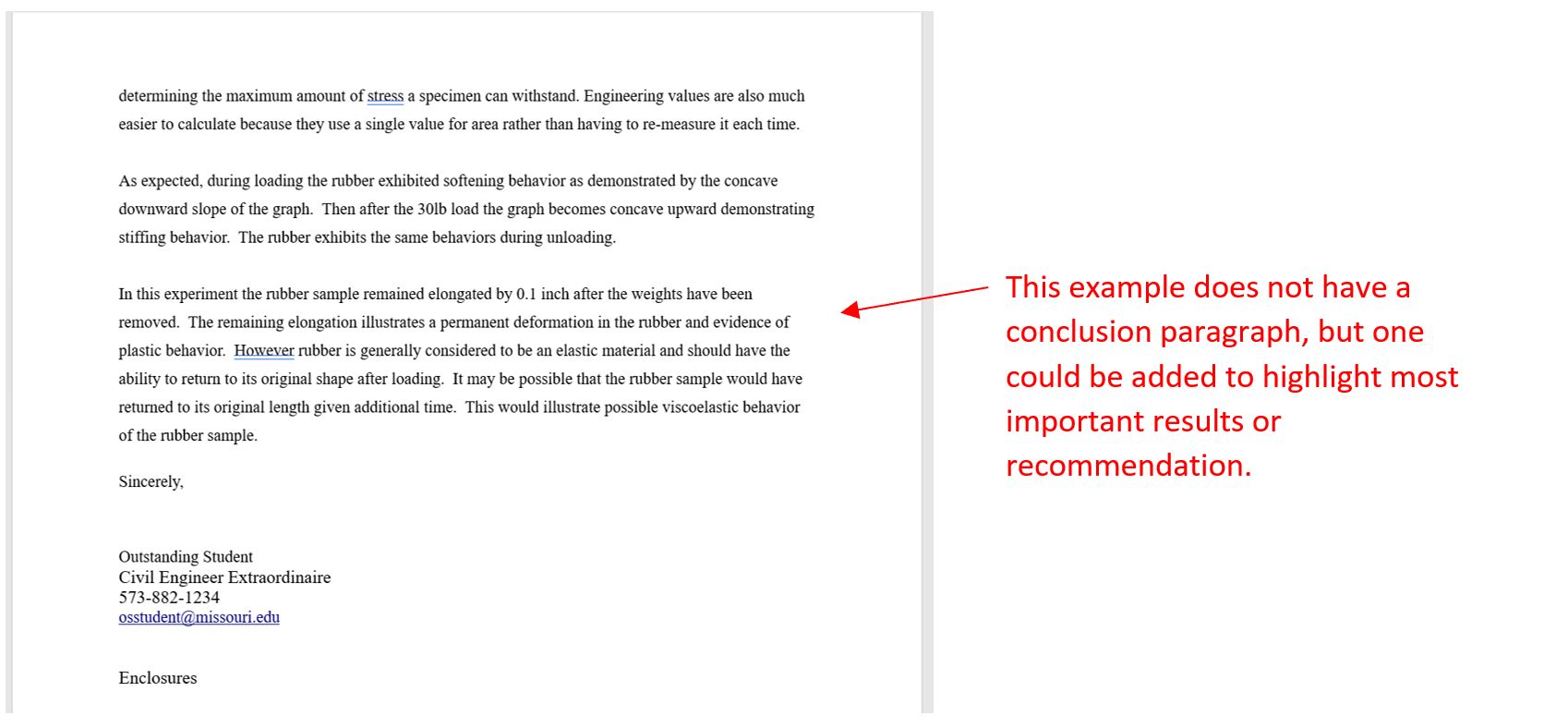The format or flow of information is important in helping the reader easily understand and process the information. Learn more about the common format used in technical reports and how to use citations and references.
General Format
The format or flow of information is important in helping the reader easily understand and process the information. The format builds the scaffold upon which the communication is based. A strong consistent and recognizable format aids the reader in processing the information
In general, there is an orderly explanation that explains the logic of the work. The paragraphs are also arranged in a consistent format usually starting with a topic sentence and then other sentences related to the topic of the paragraph.
The format of the technical writing depends on the audience and purpose. A short memo may simply describe the purpose of the memo in the first paragraph and answer a few key questions in the subsequent paragraphs. A comprehensive lab or design report will be longer and typically divided into many sections. There is not one “correct” format. The main importance is that the writing is structured so that the reader can easily and quickly recognize important information. This section provides some format examples for technical reports and memos. The formatting requirements for citations, references, cross-references, and cover sheets are the same for all written communications.
Citations
Most technical reports reference other sources of information. As such, the use of citations and cross-references is important. If you are discussing the ideas in a source at length (for example, in a summary), you do not need to cite every consecutive sentence. Cite the first time you mention the source, as long the following sentences clearly indicate that the ideas come from the same source.
There are two common conventions in Engineering: 1) the author-date format and 2) the numerical format. You will use the author date format for all assignments in Engineering, however the numerical format is required by some journals (such as the American Concrete Institute journals).
Author-date format
The author-date format is the default format used by the ASCE style guide (https://ascelibrary.org/doi/10.1061/9780784479018.ch03) and will be the default format you will use in reports for the Civil Engineering program. The in-text citations consist of the names of individuals and corporate authors and the year of publication of the cited work in parentheses immediately following the information cited. All citations must appear in the list of references.
Examples
Basic format:
- Paraphrased information – you have gathered information from the source(s) but you are not directly copying what they have written.
- Reinforced concrete (RC) flat-plate structures, as compared with other RC structural systems, generally cost less and are faster to construct (Gilsanz et al. 2015).
- Quoted information – you want to maintain the way the original text wrote the information. Try not to use quotations unless it is important to maintain the text. In the following example, the code language may be under discussion so the exact language of the code is quoted.
- “Buildings and other structures shall be designed to sustain local damage with the structural system as a whole remaining stable and not being damaged to an extent disproportionate to the original local damage.” (ASCE 2002, p. 2)
- If the author is mentioned in sentence – Indicate year of publication only in parentheses following the author’s name.
- Qian and Li (2014) performed static and dynamic loading tests of multi-panel flat-plate subassemblies with reduced scales to examine the collapse resistance of flat plates.
- Two individual authors – Include the last name of each author.
- Construction failure is avoidable (Feld and Carper 1977).
- Three or more individual authors – The first author’s name is given, followed by “et al.” (no italics) and the year.
- Innovative technologies can be used to determine the longevity of key infrastructure features (McCullough et al. 2004).
- Multiple works produced by the same author(s) in the same year – Designate works with sequential lower-case letters appended to the year.
- Previous cases of progressive collapse of buildings have been investigated by Sasani et al. (2007a, 2007b).
Numerical format
The numerical format is preferred by some journals and other publications. In this format, all the references are arranged numerically by the order in which they appear in the text. The citation simply consists of the number related to that reference either as a superscript or in brackets. This uses less room for the citation, but also does not provide information on who wrote the report or when the report was written.
- Construction failure is avoidable1. -Or- Construction failure is avoidable [1].
If the author is mentioned in the sentence, the number is still used.
- According to Wynham2, no additional support is necessary. -Or- According to Wynham [2], no additional support is necessary.
References
References give the reader the information they need to know so that they can find the reference for more information. Depending on where the report is published, the required format for the references may be slightly different. In Civil Engineering, the default format is the ASCE style. The excerpt below is directly from the ASCE style guide.
Books
If a whole book is used (or pages here and there throughout the book), page numbers need not be given. If no author is listed, titles should be alphabetized. If a specific chapter is being used, the chapter title and inclusive page numbers should be included. Reports must include the full institution name and location.
- Evans, G. M., and Furlong, J. C. (2003). Environmental biotechnology: Theory and applications, Wiley, Chichester, U.K.
- Moody’s municipal and government manual. (1988). Moody’s Investors Service, New York.
Building Codes and Provisions
Building codes, provisions, and standards should be listed alphabetically by the name of the promulgating institution. If a title and code number are given, the title should be in quotes, and the code number in italics; if only a title is given, the title should be in italics.
- ACI (American Concrete Institute).(1989). “Building code requirement for reinforced concrete.” ACI 318-89,Farmington Hills, MI.
- Building Officials and Code Administrators International (BOCA). (1993). The BOCA national building code, Country Club Hills, IL.
- CEN (European Committee for Standardization). (1992). “Design of steel structures, part 1.1.” Eurocode 3, Brussels.
Electronic Materials
CD-ROM—The section, chapter, and page numbers should be provided if available:
- Liggett, J. A., and Caughey, D. A. (1998). “Fluid statistics.” Fluid mechanics(CD-ROM), ASCE, Reston, VA, Section …, Chapter …, pp. …
Website
The following elements should be included: author’s name (if known); year of publication or last revision (if available); full title of the document, in quotation marks; title of the complete work (if applicable), in italics; full web address, enclosed within angle brackets; and date of the visit (if applicable), in parentheses. If the Web page shows no year of publication, the year of the visit may be used in its place.
- Arizona Dept. of Commerce. (2005). “Community profile: Hualapai Indian Reservation.” 〈http://www.azcommerce/com/doclib/commune/ualapai.pdf〉(Mar. 17, 2014).
- “Acquisition reform network.” (1998). Arnet, 〈http://www.arnet.gov〉(Jan. 21, 2010)
Journal Articles
The standard format for a paper published in a U.S. journal is as follows:
Beskos, D. E. (1987). “Boundary element methods in dynamic analysis.” Appl. Mech. Rev.,40(1), 1–23.
ASCE Journals
ASCE no longer uses page numbers and has adopted a new format for its references (including those older papers that still contain page numbers). Use the following style for citation to an ASCE journal:
- Authors. (Year of initial publication). “Title of paper.” Journal abbr., DOI, CID/page range.
- Irish, J. L., and Resio, D. T. (2013). “Method for estimating future hurricane flood probabilities and associated uncertainty.” J. Waterway, Port, Coastal, Ocean Eng., 10.1061/(ASCE)WW.1943-5460.0000157, 04013015.
ASCE Committee/Technical Reports
ASCE committees, task forces, etc. publish reports, proposed codes and standards, commentaries on codes and standards, and so on. The committee is the author.
- ASCE Task Force on Friction Factors in Open Channels. (1963). “Friction factors in open channels.” J. Hydraul. Div., 89 (2), 97–143.
Cross-References
In addition to referencing other sources of information, cross-references are also used to refer to figure, tables, and equations within the report. You must refer to every table, figure, equation used in the text. For documents in Engineering use the full reference (i.e. Figure #, Table #, Equation #) instead of an abbreviation (i.e. Fig., Eq.). If the item (figure, table, or equation) is a noun in the sentence then use it as a proper noun and capitalize the first letter.
- Figure 1 shows the stress-strain curve of aluminum.
- The stress-strain curve of aluminum is shown in Figure 1.
If the item (figure, table, equation) serves as a reference (where to go for more information), then include it in parentheses.
- The stress-strain curve of aluminum is non-linear (Figure 1).
All exhibits (Figures, Tables, Equations) should be sequentially numbered throughout the report (don’t skip numbers) and the cross-reference in the text should occur before the figure. If you change the order of your figures you have to renumber them. If the report is in several chapters, then the number may contain a chapter and/or sub-chapter number (i.e. Figure 3-4). The use of automatic features in Word makes keeping track of these things easier.
You can also use cross-references to refer to different sections in the report. This is common in technical reports in which the chapters and sub-sections are numbered.
- Refer to Section 4.13 for details of the test setup.
Cover Sheet
Many reports will contain a cover sheet that provides basic information. The layout of the cover sheet may be dictated by whomever is to receive the report (i.e. the Graduate School has a pre-determined layout for thesis and dissertations). The cover sheet will generally include the following information:
- Title of report
- Your name
- Names of group members (where appropriate)
- Date submitted
Example Cover Sheet

Alternatively, you may be asked to provide a cover letter to a report or homework assignment. The cover letter also serves to identify the topic and authors of the report, but is written in the format of a letter and contains contact information.
Example Cover Letter

Technical Reports
Technical Report Organization
Most technical reports follow the well-recognized general organization described in this section. This can be applied to technical reports, lab reports, journal papers, etc. A technical report is usually divided into distinct sections. A common format for a report is as follows:
Introduction – explains what the report is about and why is it is needed.
- Procedures – If the report is based on an experiment (lab) then this describes the procedure and apparatus used. If the report is a design report, then this may be the design procedures and calculations.
- Analysis/Results – reports the outcomes of the experiment or design.
- Discussion – explains the significance of the results and suggested recommendations.
- Conclusions – summarizes the main points of the report. Nothing new is presented in the conclusions.
Each section should be able to “stand on its own”. Meaning that if you need to refer to information in a previous section you should use an appropriate cross-reference (i.e. see Section 4.3.2 for …). In addition, the sections should have a logical flow and structure within themselves. Each paragraph should define or explain a single topic, and there should be organization, transitions, and flow between the paragraphs.
An example annotated technical report is found in the examples section of the Communication Toolbox. Use the report for an example of each of the sections described next.
Cover Sheet
Many reports will contain a cover sheet that provides basic information. The layout of the cover sheet may be dictated by whomever is to receive the report (i.e. the Graduate School has a pre-determined layout for thesis and dissertations). The cover sheet will generally include the following information:
- Title of report
- Your name
- Names of group members (where appropriate)
- Date submitted
Abstract/Executive Summary
An abstract (usually found in journal or research papers) or executive summary (usually found in technical reports) tells the reader quickly what the report is about. Generally, this section is only about 1 page long and concisely covers the goal of the work (why it was done), what was done (experiments or designs performed), and major conclusions (what was determined, suggested actions).
Introduction
The first part of the technical report is the introduction. This sets the stage for the reader and provides needed background information. As such, the introduction must cover the purpose of the design/experiment, scope of work, and any needed background knowledge.
- Scope of Work – The scope of work is a description of the design or laboratory. This section should include a brief description of the project and outline the calculation requirements.
- Given Information – This section should include information given in the problem statement. Typically, this section includes information that is provided by the professor or client and does not require interpretation.
- Assumptions – This section should briefly describe any assumptions that are made in addition to the project description and requirements. Typically, assumptions are made by the engineer, not the client, and can be modified or changed.
- Background – This section provides the needed technical background for the reader. If the reader is not familiar with this area of study this section will need to be quite detailed so that the reader can fully understand the experiment and results. Sometimes the background is it’s own separate chapter/section in a report.
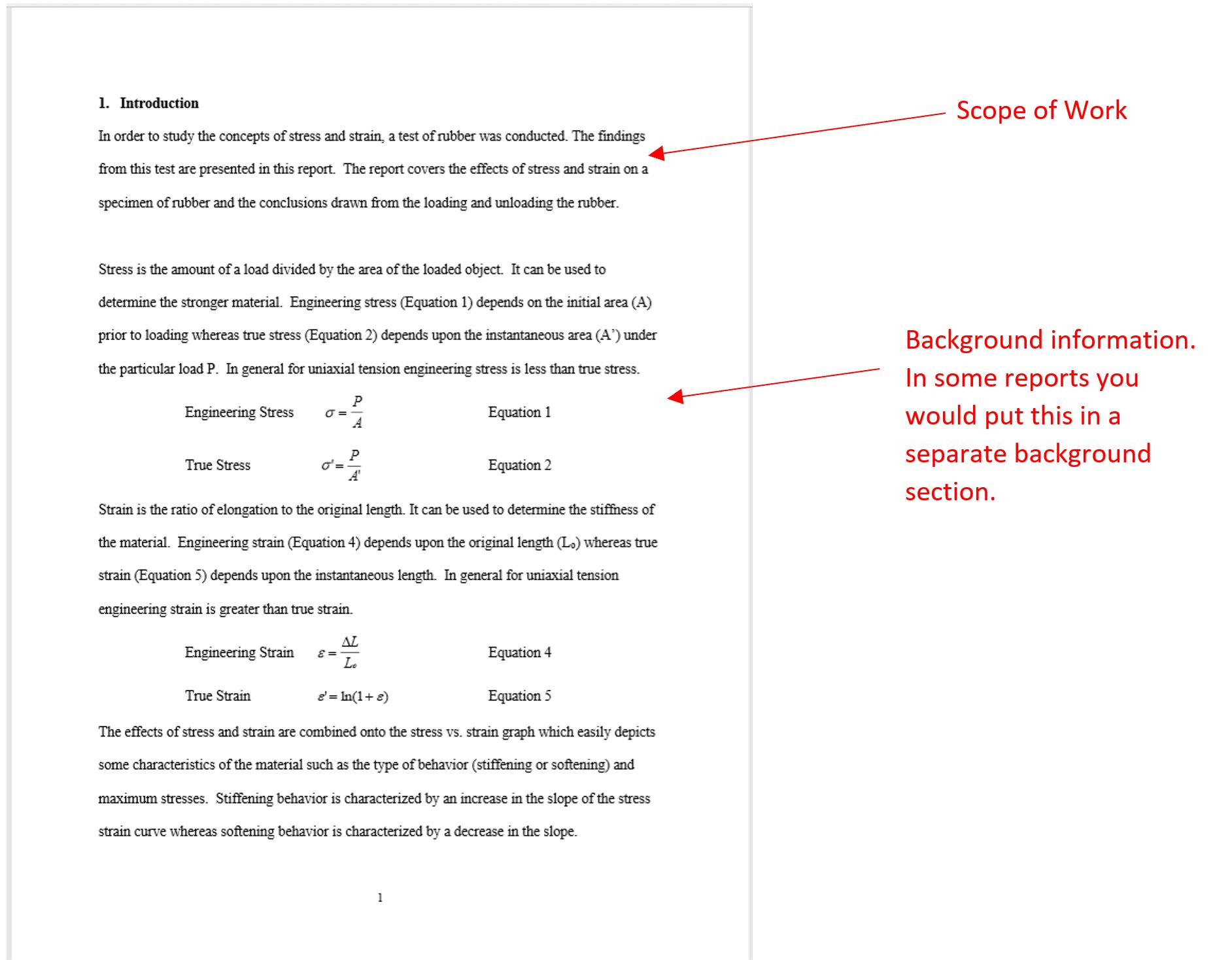
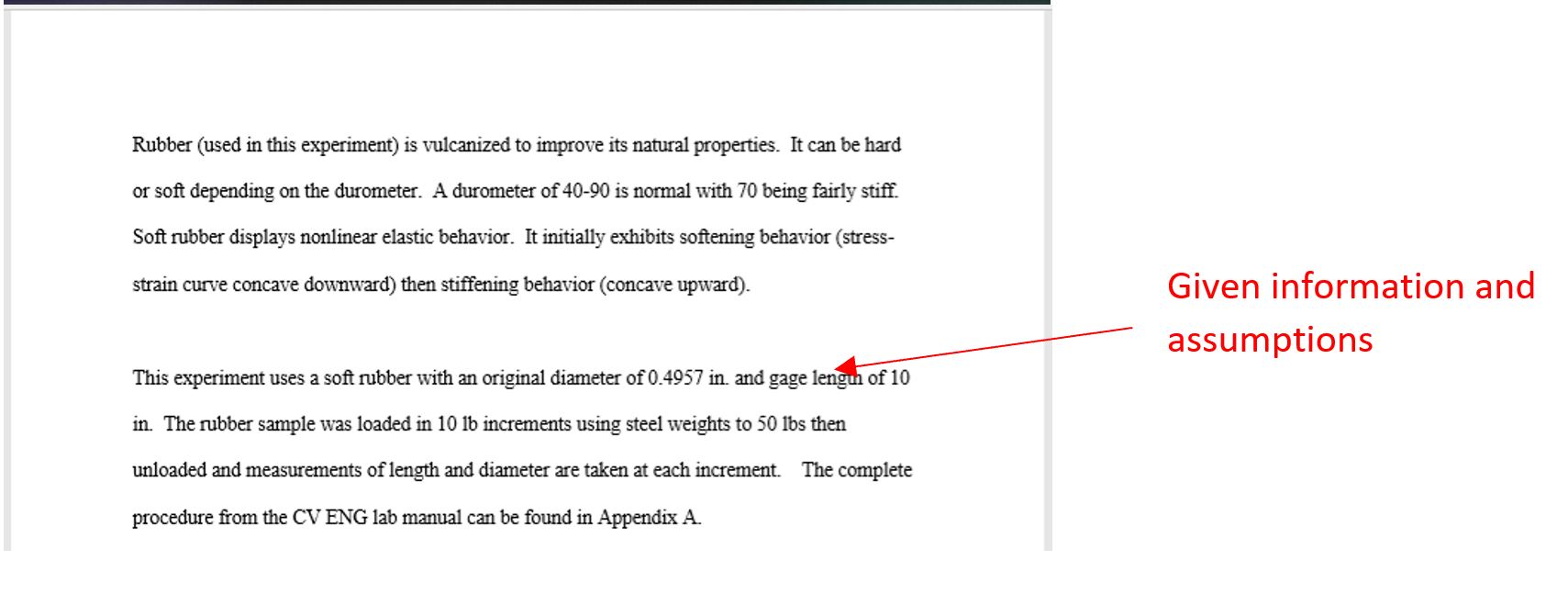
Procedures
This can be used to describe the equipment and procedures used for a lab experiment, or the basis/assumptions, codes, etc. used for a design. Usually one of the easiest sections to write – you are simply saying what was done and how it was done. Be sure to be concise with your writing (no overly long explanations) and make sure you completely cover the procedure (someone else could repeat the experiment or design based on the information you give them).

Results
The results section simply states the results of the design or laboratory experiments. Depending on your writing style you may combine this section with the discussion section. It consists of properly formatted tables and figures with explanations and descriptions of the tables and figures (you must reference every table and figure in the text). You should present without analyzing or commenting on significance (unless you are combining it with discussion).
In an experimental or laboratory research report the results will typically consist of the results of the calculations and/or experimental data. It typically consists of the tables and figures as well as clear and direct wording that highlights the most important results. Do not draw conclusions or make comparisons to other work in this section (that is for the discussion). Reference to the table and figures must be provided in the main body of the report.
In a design report the results typically consist of calculation work done in interpreting the design. If the calculations required are not extensive then this can be included in the main body of the report. Each step in the calculations should have a brief description. Provide equations used. Each equation should have a number for reference and all variables should be defined. If the calculations are extensive they can be included in the appendix (i.e. Sample Calculations), however a brief summary of the procedure should be in the main body of the report.
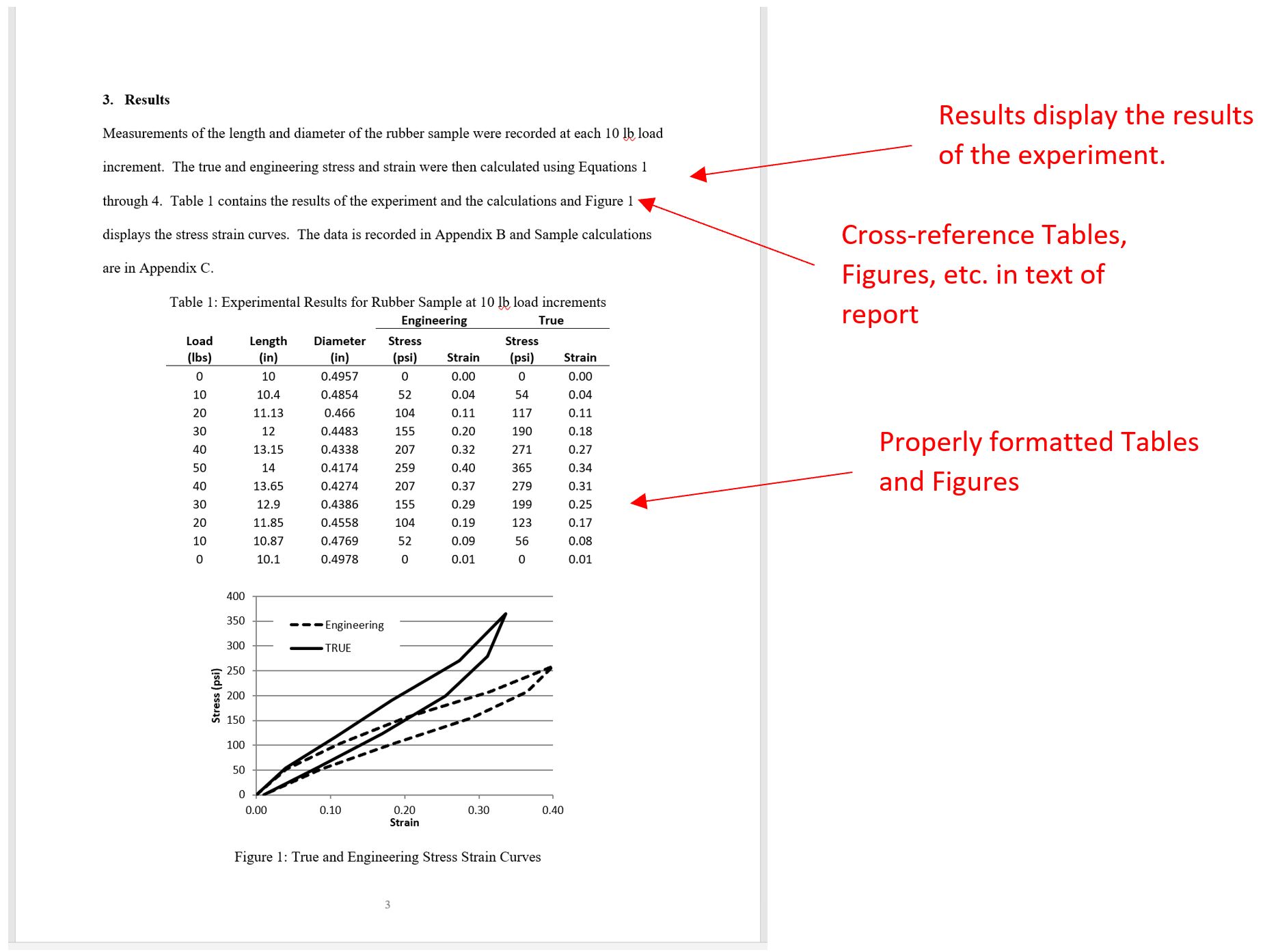
Discussion
The next section is the discussion of the results. This is the heart of the technical report and shows what you determined in the design or learned from the experiment.
In an experimental or laboratory research report, you should analyze your results by discussing the data and interpreting your results. State the significance of your results clearly, and compare your results with theory or other work. Be sure to use quantitative comparisons in your discussion. Indicate if the results support the underlying theory or contradict it.
In a design report, you should highlight the main recommendations of the design or compare the design with other alternatives. This may be where you evaluate the value vs. cost of the proposed design. The reader should have a clear understanding of why this design was chosen.
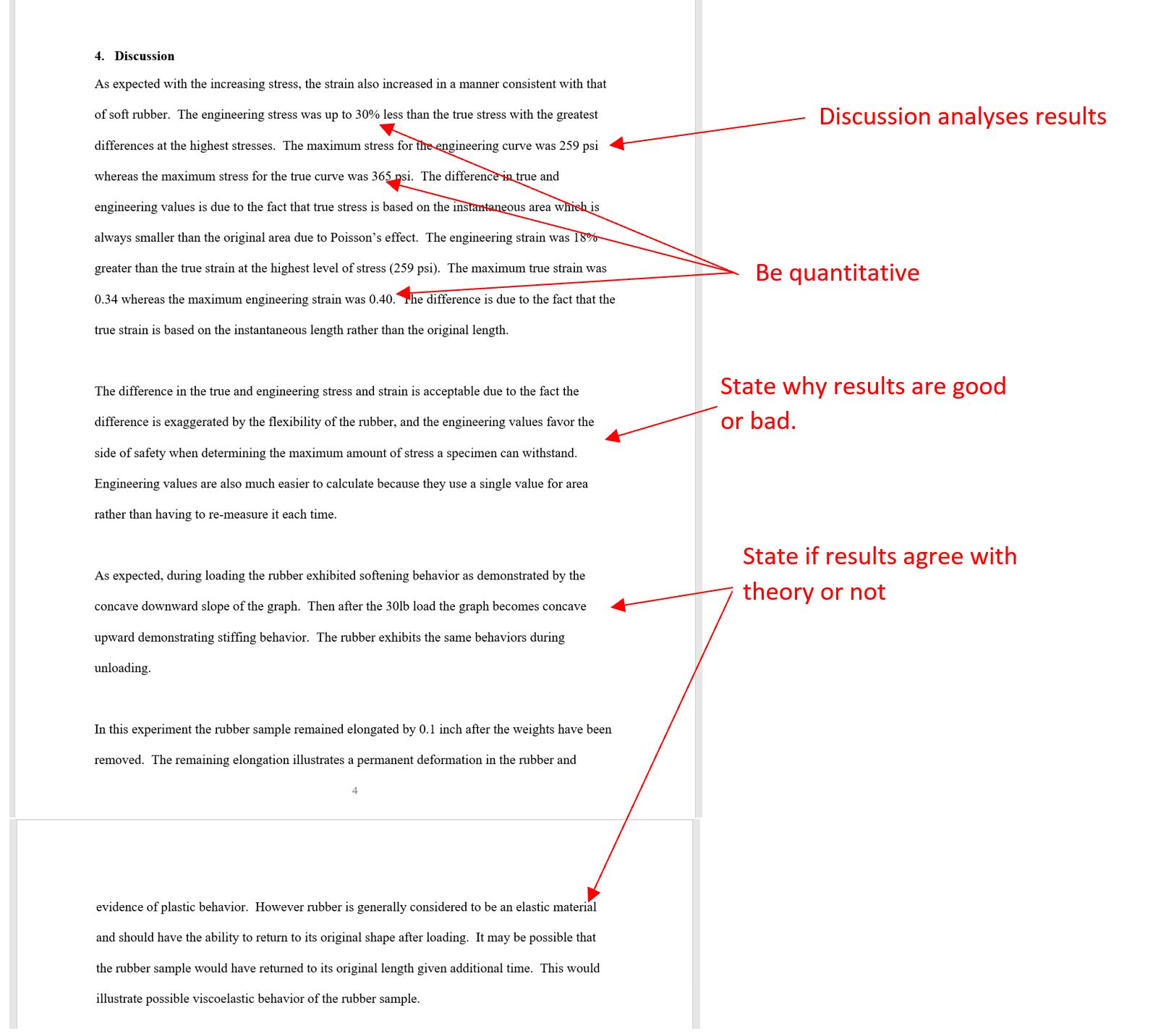
Conclusions
The final section of the report is the conclusions. This section sums up what was learned from the experiment or recommended in the design. It generally focuses on restating the main discussion points. There should be nothing new presented in this section – all points were previously covered in more detail earlier in the report.
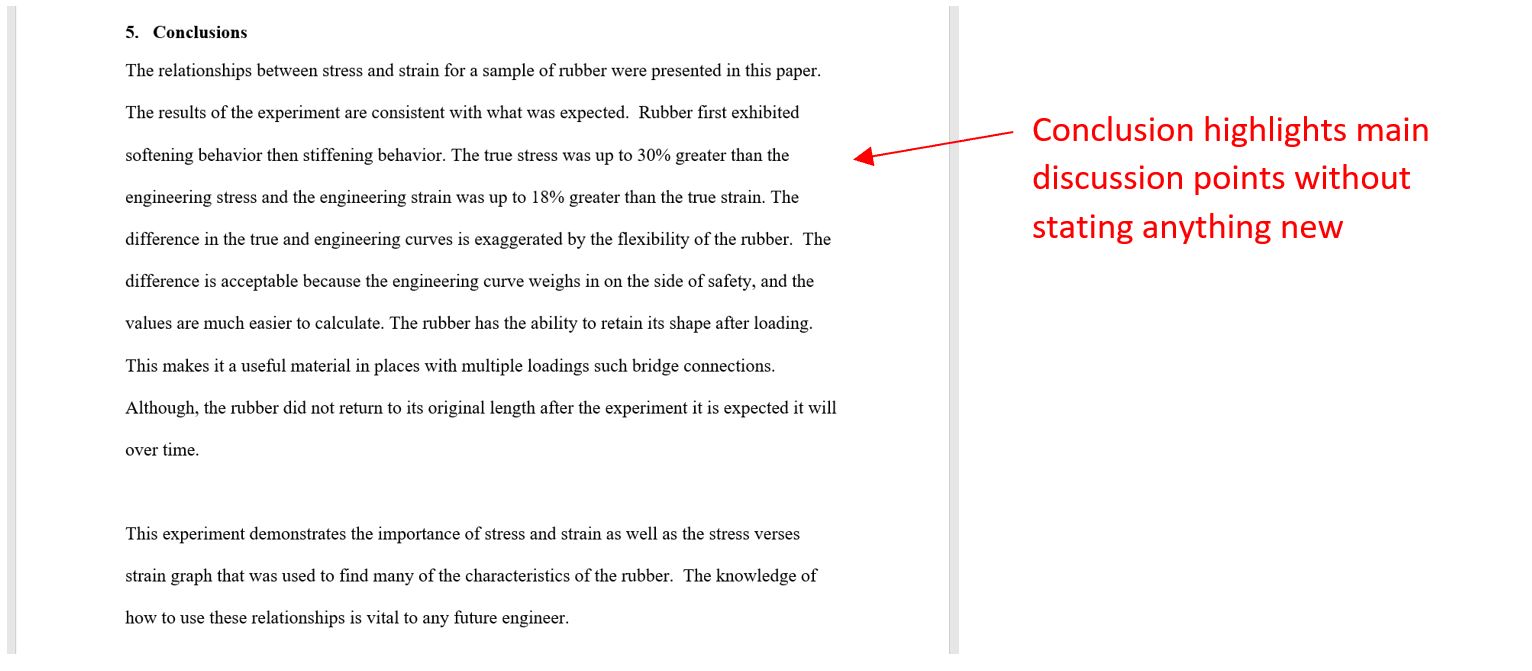
Appendices
The appendices are used to document the information that is not included in the main body of the report. For example, the data that you measured in the laboratory, sample calculations, and mathematical derivations should be presented in the appendices. You can have more than one appendix. Assign each appendix a letter and a title, and group the items in a sensible manner – for example, “Appendix A: Measured Data.” Data that are not mentioned in your results should not be included in the appendices. When mathematical terms are used in the report, include an appendix titled “Notation.”
For the appendix sample calculations equations should be presented for each type of calculation along with a numerical example. For example, if stress is calculated for many data points provide the equation for stress and an example of one stress calculation. There should be equations and examples for every type of calculation conducted in analyzing the data. The calculations should be clear and legible – this may require writing the calculations in a computer program or handwritten in a dark pen in order to scan well.
Technical Memos
Technical Memo Organization
Technical memos are essentially short technical reports geared to answer specific client questions. Generally, memos are much shorter than reports (only 1 to 2 pages) and have less introductory and background information. Often the memos are in the form of a letter or an email. Results are often given in a supplementary section (enclosure in a letter or attachment to an email).
- Subject line – regardless of whether the form is a letter or email, there needs to be a short subject line for the memo
Addressee – Memos are written for someone. You should address the memo to a person or a committee or group. - Introductory paragraph – Although the introduction is not a long as in a report, the memo still needs to state the purpose of the memo and any assumptions or given information that was used in the experiment or design.
- Discussion paragraphs – These paragraphs answer the specific questions of the client. They are similar to a report discussion, but more targeted to the audience and the questions asked. All discussions should be quantitative.
- Conclusion – This optional paragraph may sum up some important points or recommendation. It can also provide encouragement for the client to contact you for more information.
Example Technical Memo


